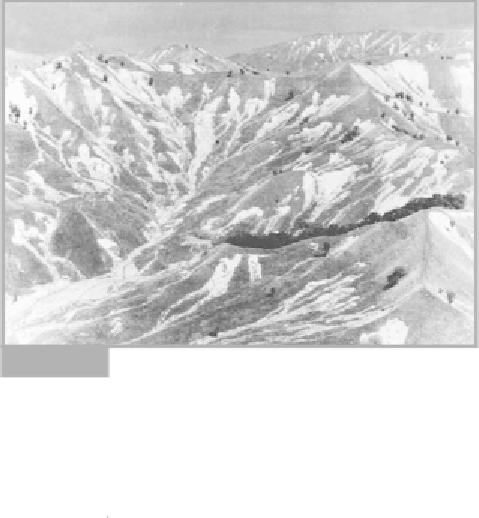Geoscience Reference
In-Depth Information
was one of the more tragic disasters of this nature.
A 250 m high, fine-grained, rain-soaked coal tailings
pile failed and turned into a debris flow, which swept
through a school killing 116 children, the entire
juvenile population of the town. A similar flow in a coal
mining waste dump in West Virginia killed 118 people
in 1972. The Aberfan disaster illustrated the unsafe
nature of coal tailings in the United Kingdom - over
25 per cent were subsequently found to be in a similar
condition of instability.
Nothing in recent history matches the Caracas,
Venezuela, floods of 15-17 December 1999. Cen-
turies ago, Caracas was deliberately built inland,
behind the 2700 m high El Ávila coastal range, to hide
the city from invaders. It has grown to a city of
5 million people plagued by the worst characteristics
of Third World urban centers: slums with high
densities of 25 000 km
-2
built in hazard-prone areas,
haphazard construction, lack of planning, and unen-
forceable building codes. Hillsides with 80 per cent
slopes have been built upon. The disaster began
during a month of rain, culminating in over 900 mm
falling in a 72-hour period between 15 and 17
December. The rain triggered landslides, mudflows
and, worst of all, debris flows, killing an estimated
30 000 people. While the rains were excessive, prob-
ability analysis has shown that 300 mm or more of rain
in 24 hours could be experienced once in 25 years.
Similar floods had occurred in 1798, 1912, 1914,
1938, 1944, 1948, and 1951. Geomorphic evidence
indicated debris flows were common. The rains of
1999 reactivated nine large alluvial fans on the coastal
side of the El Ávila range and created 28 slides
containing as much as 58 500 m
3
of material. Unfor-
tunately, the fans had been urbanized (Figure 12.11).
The rains also stripped steep slopes of their regolith
and moved boulders with dimensions as large as
11.3
Widespread debris flows initiated on slopes of 12-30°
in the Kiwi Valley area, Wairoa, New Zealand, by
intense rainfall in February 1977. Rainfall intensities of
127 mm in 2 hours, and 252 mm in 5.5 hours, were
recorded (photograph courtesy of the Hawke's Bay
Catchment Board, Napier, New Zealand).
Fig. 12.10
at higher velocities. Such an event is termed a debris
avalanche and will be discussed in detail below. When
mudflows and debris flows stop, excess water tends to
drain from the deposit, forming either lobate or planar
fans. In some cases, where subsequent filtering out of
sediment has happened, flow deposits can be mistaken
for alluvial fan deposits. The thickness of the deposit is
inversely proportional to the fluidity of the deposit, and
to the slope angle at rest.
Under extreme wetness, both mudflows and debris
flows can liquefy, whereupon the weight of material is
borne by pore-water pressure and not grain-to-grain
contacts. This problem is particularly severe in
marine clays laid down following the retreat of the
last major glaciation. Subsequent desalinization forms
quick clays, which are very susceptible to lique-
faction. The St Lawrence Valley in eastern Canada
was effectively flooded by the ocean during the
waning phases of continental glaciation, with the sub-
sequent deposition of extensive, thick clay beds
susceptible to earth flow and liquefaction. Mudflows
with volumes in excess of 20 million m
3
have been
quite common in this region. The St Jean-Vianney,
Quebec, failure in 1971 took 35 lives. Similar types of
deposits have been recorded in Scandinavia and
Russia. In 1893, at Vaerdael, Norway, 112 people
were killed by one such failure.
Unstable mine tailings can also generate debris
flows. The Aberfan, Wales, disaster of 21 October 1966
3.5 m, and volumes of 1310 m
3
, down-
stream. Debris flow velocities reached 14.5 m s
-1
.
Under these conditions, buildings up to eight storeys
high were destroyed. The extent of the disaster was
awesome. The volume of sediment moved in individ-
ual debris flows reached 1.9 million m
3
, amongst the
largest ever recorded. However, these volumes are at
least an order of magnitude smaller than the largest
triggered by volcanic explosions, eruptions, or
earthquakes. Over 8000 homes and 700 apartment
buildings were destroyed or damaged. The damage
bill totalled $US1.8 billion.
5.0





